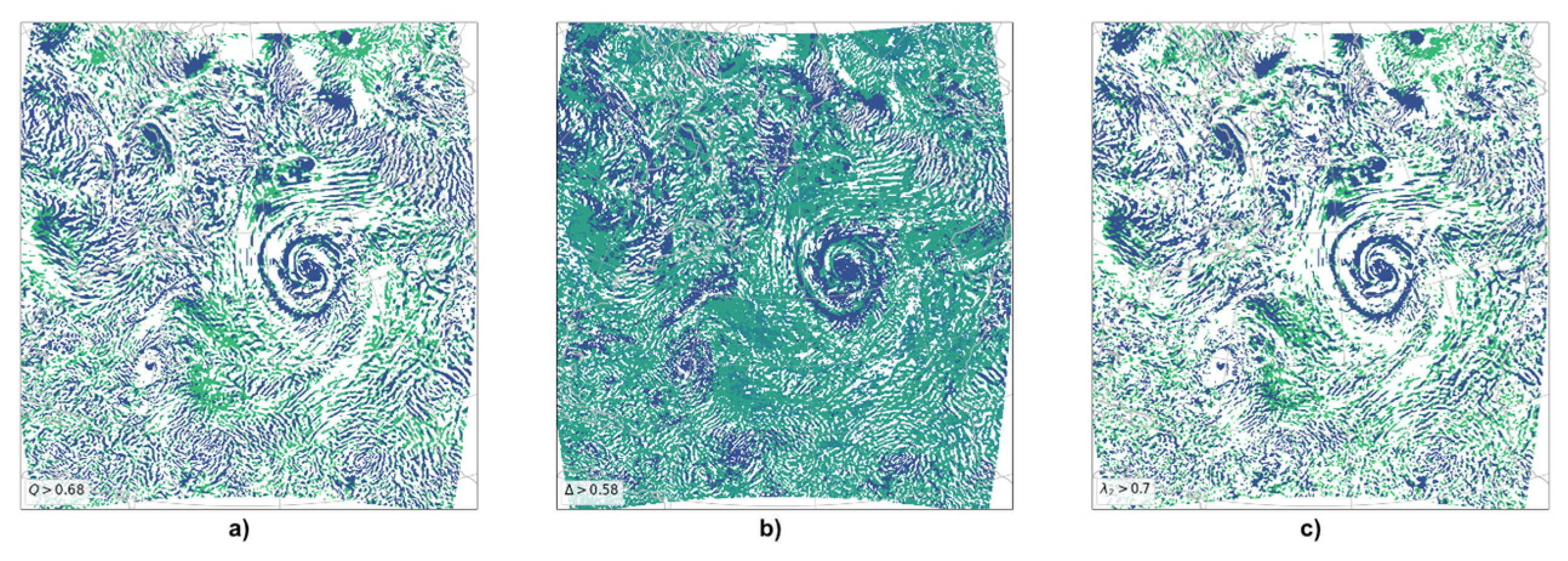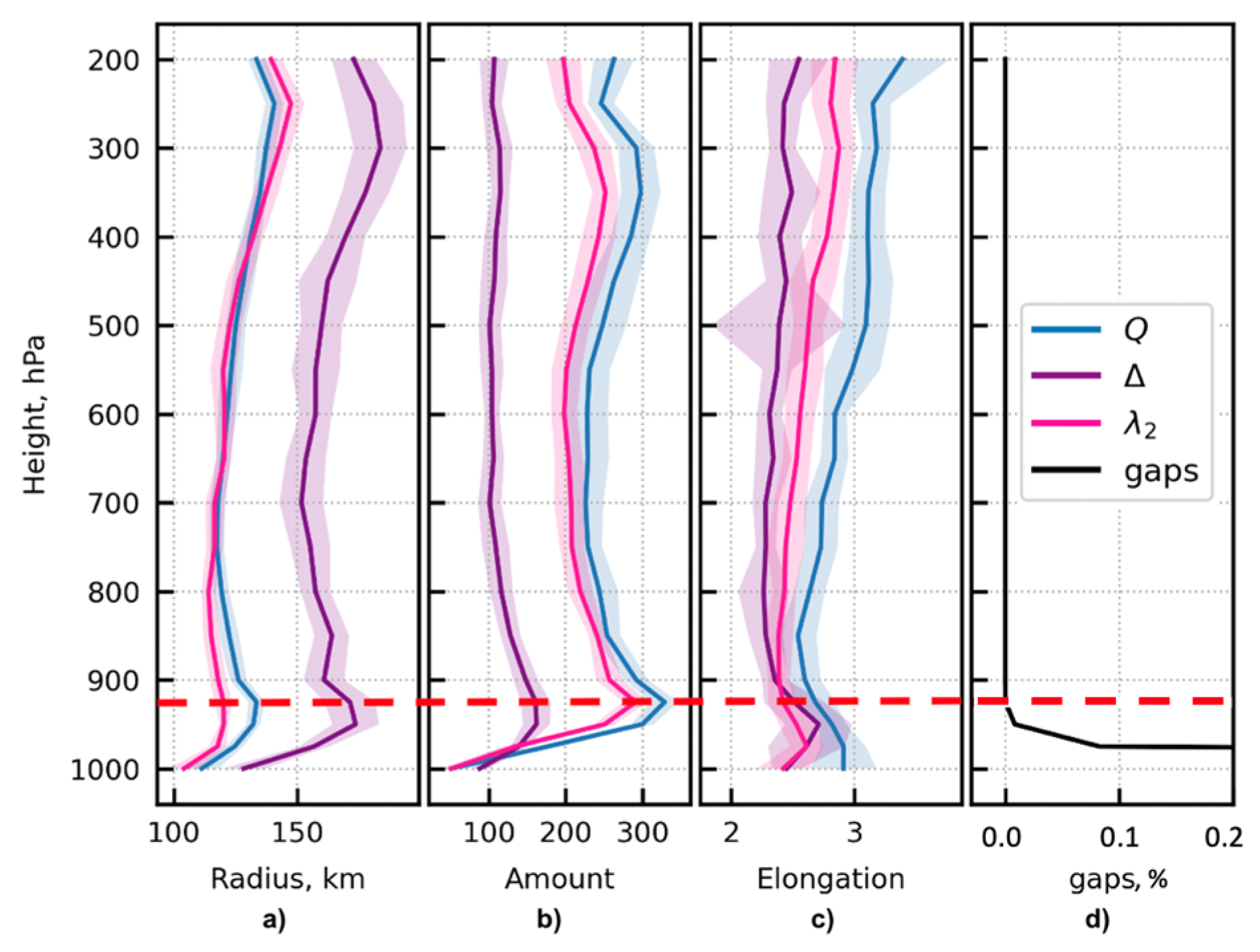Methods of Identification Coherent Structures in Atmospheric Numerical Data †
Abstract
:1. Introduction
2. Materials and Methods
2.1. Basic Vortex Identification Criteria
2.1.1. Q-Criterion
2.1.2. Δ-Criterion
2.1.3. -Criterion
2.2. Data
2.3. Data Processing
3. Results
4. Discussion
Author Contributions
Funding
Institutional Review Board Statement
Informed Consent Statement
Data Availability Statement
Conflicts of Interest
References
- Hunt, J.C.R.; Wray, A.A.; Moin, P. Eddies, Streams, and Convergence Zones in Turbulent Flows; Center for Turbulence Research, Proceedings of the Summer Program: Washington, DC, USA, 1988; pp. 193–208. [Google Scholar]
- Okubo, A. Horizontal dispersion of floatable particles in the vicinity of velocity singularities such as convergences. Deep-Sea Res. Oceanogr. Abstr. 1970, 17, 445–454. [Google Scholar] [CrossRef]
- Weiss, J. The dynamics of enstrophy transfer in two-dimensional hydrodynamics. Phys. D Nonlinear Phenom. 1991, 48, 273–294. [Google Scholar] [CrossRef]
- Lugt, H.J. The Dilemma of Defining a Vortex. In Recent Developments in Theoretical and Experimental Fluid Mechanics; Springer: Berlin/Heidelberg, Germany, 1979; pp. 309–321. [Google Scholar]
- Perry, A.E.; Chong, M.S. A description of eddying motions and flow patterns using critical-point concepts. Annu. Rev. Fluid Mech. 1987, 19, 125–155. [Google Scholar] [CrossRef]
- Chong, M.S.; Perry, A.E.; Cantwell, B.J. A general classification of three-dimensional flow fields. Phys. Fluids A 1990, 2, 765–777. [Google Scholar] [CrossRef]
- Jeong, J.; Hussain, F. On the identification of a vortex. J. Fluid Mech. 1995, 285, 69–94. [Google Scholar] [CrossRef]
- Gavrikov, A.; Gulev, S.K.; Markina, M.; Tilinina, N.; Verezemskaya, P.; Barnier, B.; Dufour, A.; Zolina, O.; Zyulyaeva, Y.; Krinitskiy, M.; et al. RAS-NAAD: 40-yr High-Resolution North Atlantic Atmospheric Hindcast for Multipurpose Applications (New Dataset for the Regional Mesoscale Studies in the Atmosphere and the Ocean). J. Appl. Meteorol. Climatol. 2020, 59, 793–817. [Google Scholar] [CrossRef]
- Koláˇr, V. Vortex identification: New requirements and limitations. Int. J. Heat Fluid Flow 2007, 28, 638–652. [Google Scholar] [CrossRef]
- Skamarock, W.C.; Klemp, J.B.; Dudhia, J.; Gill, D.O.; Barker, D.M. A Description of the Advanced Research WRF Version 3; NCAR Technical Note; NCAR: Boulder, CO, USA, 2008; p. 125.
- Schubert, E.; Sander, J.; Ester, M.; Kriegel, H.P.; Xu, X. DBSCAN revisited, revisited: Why and how you should (still) use DBSCAN. ACM Trans. Database Syst. 2017, 42, 1–21. [Google Scholar] [CrossRef]



Disclaimer/Publisher’s Note: The statements, opinions and data contained in all publications are solely those of the individual author(s) and contributor(s) and not of MDPI and/or the editor(s). MDPI and/or the editor(s) disclaim responsibility for any injury to people or property resulting from any ideas, methods, instructions or products referred to in the content. |
© 2023 by the authors. Licensee MDPI, Basel, Switzerland. This article is an open access article distributed under the terms and conditions of the Creative Commons Attribution (CC BY) license (https://creativecommons.org/licenses/by/4.0/).
Share and Cite
Koshkina, V.; Gavrikov, A.; Krinitskiy, M. Methods of Identification Coherent Structures in Atmospheric Numerical Data. Environ. Sci. Proc. 2023, 26, 198. https://doi.org/10.3390/environsciproc2023026198
Koshkina V, Gavrikov A, Krinitskiy M. Methods of Identification Coherent Structures in Atmospheric Numerical Data. Environmental Sciences Proceedings. 2023; 26(1):198. https://doi.org/10.3390/environsciproc2023026198
Chicago/Turabian StyleKoshkina, Vasilisa, Alexander Gavrikov, and Mikhail Krinitskiy. 2023. "Methods of Identification Coherent Structures in Atmospheric Numerical Data" Environmental Sciences Proceedings 26, no. 1: 198. https://doi.org/10.3390/environsciproc2023026198
APA StyleKoshkina, V., Gavrikov, A., & Krinitskiy, M. (2023). Methods of Identification Coherent Structures in Atmospheric Numerical Data. Environmental Sciences Proceedings, 26(1), 198. https://doi.org/10.3390/environsciproc2023026198





